Leader of the Liberal Party of Australia
The Leader of the Liberal Party is the highest office within the Liberal Party of Australia and the Liberal–National Coalition. The position is currently, and has been since 24 August 2018, held by Prime Minister Scott Morrison, who represents the Division of Cook in New South Wales. Scott Morrison is the fourteenth leader of the Liberal Party.
| Leader of the Liberal Party | |
|---|---|
| Type | The Honourable |
| Member of | Federal Executive, Coalition |
| Term length | No fixed term |
| Inaugural holder | Robert Menzies |
| Formation | 21 February 1945 |
| Unofficial names | Leader of the Coalition |
| Deputy | Josh Frydenberg |
| Website | Scott Morrison |
The current Deputy Leader of the Liberal Party is Member for Kooyong and Treasurer, Josh Frydenberg. Frydenberg was elected under the same circumstances as Scott Morrison after the 2018 leadership spills.
History
The Liberal Party leadership was first held by former United Australia Party leader and eventual co–founder Robert Menzies, along with eighteen political organisations and groups.[1]
Scott Morrison is the current leader and was elected to be Leader and Prime Minister, first in a leadership spill,[2][3] and second, in an upset federal election victory on the 18th of May 2019.[4][5]
Following the oustings of two Liberal Prime Ministers in 3 years, Scott Morrison introduced a new threshold to trigger a Liberal Party leadership change in government, requiring two-thirds of the partyroom vote to trigger a spill motion. The change was introduced at an hour long party room meeting on the evening of 3 December 2018. Morrison said the changes, which were drafted with feedback from former prime ministers John Howard and Tony Abbott, would only apply to leaders who lead the party to victory at a federal election.[6]
Role
Since the days of Menzies, the Liberal Party has either been in government with a coalition or in opposition to the Labor. Thus, the leader of the Liberal Party can often be the Prime Minister of Australia or Leader of the Opposition. Furthermore, the leader picks the Cabinet and is also the leader of the Coalition. The Liberal Party only had one leader of the party from the Senate, John Gorton, for a brief period in January 1968 before he resigned from the Senate to contest the Higgins by-election in February 1968.
Leaders of the Liberal Party
- Note: the right-hand column does not allocate height proportional to time in office.
A list of leaders (including acting leaders) since 1945.[7]
| No. | Leader (birth–death) |
Portrait | Electorate | Took office | Left office | Prime Minister (term) | |
|---|---|---|---|---|---|---|---|
| 1 | Robert Menzies (1894–1978) |
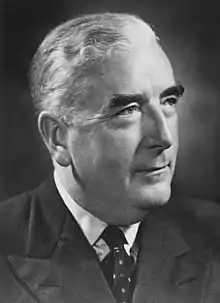 |
Kooyong, Vic. | 21 February 1945 | 20 January 1966 | Curtin (1941–1945) | |
| Forde (1945) | |||||||
| Chifley (1945–1949) | |||||||
| Himself (1949–1966) | |||||||
| 2 | Harold Holt (1908–1967) |
 |
Higgins, Vic. | 20 January 1966 (unopposed) |
17 December 1967 (died in office) |
Himself (1966–1967) | |
| 3 | John Gorton (1911–2002) |
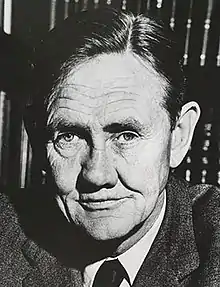 |
Higgins, Vic. | 9 January 1968 (elected) |
10 March 1971 | McEwen[lower-alpha 1] (1967–1968) | |
| Himself (1967–1971) | |||||||
| 4 | William McMahon (1908–1988) |
.jpg.webp) |
Lowe, NSW | 10 March 1971 (elected) |
20 December 1972 | Himself (1971–1972) | |
| Whitlam (1972–1975) | |||||||
| 5 | Billy Snedden (1926–1987) |
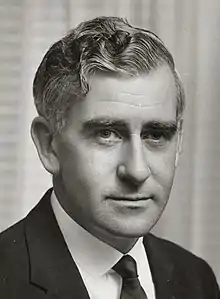 |
Bruce, Vic. | 20 December 1972 (elected) |
21 March 1975 | ||
| 6 | Malcolm Fraser (1930–2015) |
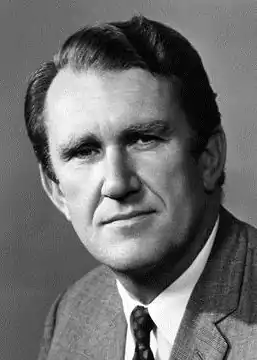 |
Wannon, Vic. | 21 March 1975 (elected) |
11 March 1983 | ||
| Himself (1975–1983) | |||||||
| Hawke (1983–1991) | |||||||
| 7 | Andrew Peacock (b. 1939) (1st time) |
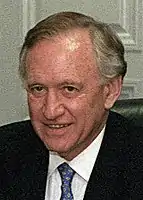 |
Kooyong, Vic. | 11 March 1983 (elected) |
5 September 1985 | ||
| 8 | John Howard (b. 1939) (1st time) |
 |
Bennelong, NSW | 5 September 1985 (elected) |
9 May 1989 | ||
| (7) | Andrew Peacock (b. 1939) (2nd time) |
 |
Kooyong, Vic. | 9 May 1989 (elected) |
3 April 1990 | ||
| 9 | John Hewson (b. 1946) |
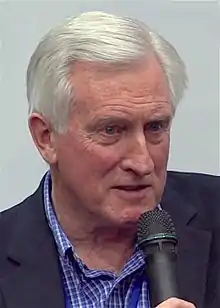 |
Wentworth, NSW | 3 April 1990 (elected) |
23 May 1994 | ||
| Keating (1991–1996) | |||||||
| 10 | Alexander Downer (b. 1951) |
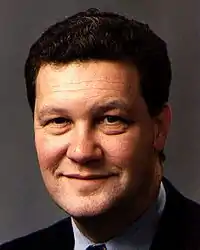 |
Mayo, SA | 23 May 1994 (elected) |
30 January 1995 | ||
| (8) | John Howard (b. 1939) (2nd time) |
 |
Bennelong, NSW | 30 January 1995 (unopposed) |
29 November 2007 | ||
| Himself (1996–2007) | |||||||
| 11 | Brendan Nelson (b. 1958) |
_(cropped).jpg.webp) |
Bradfield, NSW | 29 November 2007 (elected) |
16 September 2008 | Rudd (2007–2010) | |
| 12 | Malcolm Turnbull (b. 1954) (1st time) |
 |
Wentworth, NSW | 16 September 2008 (elected) |
1 December 2009 | ||
| 13 | Tony Abbott (b. 1957) |
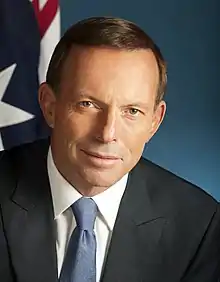 |
Warringah, NSW | 1 December 2009 (elected) |
14 September 2015 | ||
| Gillard (2010–2013) | |||||||
| Rudd (2013) | |||||||
| Himself (2013–2015) | |||||||
| (12) | Malcolm Turnbull (b. 1954) (2nd time) |
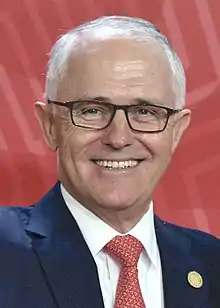 |
Wentworth, NSW | 14 September 2015 (elected) |
24 August 2018 | Himself (2015–2018) | |
| 14 | Scott Morrison (b. 1968) |
 |
Cook, NSW | 24 August 2018 (elected) |
Incumbent | Himself (2018–present) | |
Living former party leaders
There are seven living former party leaders, all of whom were elected, and four who were Prime Minister. From oldest to youngest:
| Leader | Term of office | Date of birth |
|---|---|---|
| Andrew Peacock | 1983–1985; 1989–1990 | 13 February 1939 |
| John Howard | 1985–1989; 1995–2007 | 26 July 1939 |
| John Hewson | 1990–1994 | 28 October 1946 |
| Alexander Downer | 1994–1995 | 9 September 1951 |
| Malcolm Turnbull | 2008–2009; 2015–2018 | 24 October 1954 |
| Tony Abbott | 2009–2015 | 4 November 1957 |
| Brendan Nelson | 2007–2008 | 19 August 1958 |
Federal leaders by time in office
| No | Name | Term began | Term ended | Time in office | Term as Prime Minister |
|---|---|---|---|---|---|
| 1 | Sir Robert Menzies | 21 February 1945 | 20 January 1966 | 20 years, 333 days | (UAP 1939–41), 1949–66 |
| (8) | John Howard | 30 January 1995 | 29 November 2007 | 12 years, 303 days | 1996–2007 |
| 6 | Malcolm Fraser | 21 March 1975 | 11 March 1983 | 7 years, 355 days | 1975–83 |
| 13 | Tony Abbott | 1 December 2009 | 14 September 2015 | 5 years, 287 days | 2013–15 |
| 9 | John Hewson | 3 April 1990 | 23 May 1994 | 4 years, 50 days | |
| 8 | John Howard | 5 September 1985 | 9 May 1989 | 3 years, 246 days | |
| 3 | Sir John Gorton | 10 January 1968 | 10 March 1971 | 3 years, 59 days | 1968–71 |
| (12) | Malcolm Turnbull | 14 September 2015 | 24 August 2018 | 2 years, 344 days | 2015–2018 |
| 7 | Andrew Peacock | 11 March 1983 | 5 September 1985 | 2 years, 178 days | |
| 14 | Scott Morrison | 24 August 2018 | Incumbent | 2 years, 155 days | 2018–present |
| 5 | Sir Billy Snedden | 20 December 1972 | 21 March 1975 | 2 years, 91 days | |
| 2 | Harold Holt | 20 January 1966 | 19 December 1967 | 1 year, 333 days | 1966–67 |
| 4 | Sir William McMahon | 10 March 1971 | 5 December 1972 | 1 year, 270 days | 1971–72 |
| 12 | Malcolm Turnbull | 16 September 2008 | 1 December 2009 | 1 year, 76 days | |
| (7) | Andrew Peacock | 9 May 1989 | 3 April 1990 | 329 days | |
| 11 | Brendan Nelson | 29 November 2007 | 16 September 2008 | 292 days | |
| 10 | Alexander Downer | 23 May 1994 | 30 January 1995 | 252 days | |
Totals for leaders who served multiple non-consecutive terms:
- John Howard: 16 years, 184 days
- Malcolm Turnbull: 4 years, 59 days
- Andrew Peacock: 3 years, 142 days
Federal deputy leaders
| # | Name | State | Term start | Term end | Duration | Leader(s) |
|---|---|---|---|---|---|---|
| 1 | Eric Harrison | New South Wales | 21 February 1945 | 26 September 1956 | 11 years, 218 days | Robert Menzies |
| 2 | Harold Holt | Victoria | 26 September 1956 | 20 January 1966 | 9 years, 116 days | |
| 3 | William McMahon | New South Wales | 20 January 1966 | 10 March 1971 | 5 years, 49 days | Harold Holt John Gorton |
| 4 | John Gorton | Victoria | 10 March 1971 | 16 August 1971 | 159 days | William McMahon |
| 5 | Billy Snedden | Victoria | 18 August 1971 | 20 December 1972 | 1 year, 124 days | |
| 6 | Phillip Lynch | Victoria | 20 December 1972 | 8 April 1982 | 9 years, 109 days | Billy Snedden Malcolm Fraser |
| 7 | John Howard | New South Wales | 8 April 1982 | 5 September 1985 | 3 years, 150 days | Malcolm Fraser Andrew Peacock |
| 8 | Neil Brown | Victoria | 5 September 1985 | 17 July 1987 | 1 year, 315 days | John Howard |
| 9 | Andrew Peacock | Victoria | 17 July 1987 | 9 May 1989 | 1 year, 296 days | |
| 10 | Fred Chaney[lower-alpha 2] | Western Australia | 9 May 1989 | 3 April 1990 | 329 days | Andrew Peacock |
| 11 | Peter Reith | Victoria | 24 March 1990 | 13 March 1993 | 2 years, 354 days | John Hewson |
| 12 | Michael Wooldridge | Victoria | 13 March 1993 | 23 May 1994 | 1 year, 71 days | |
| 13 | Peter Costello | Victoria | 23 May 1994 | 29 November 2007 | 13 years, 190 days | Alexander Downer John Howard |
| 14 | Julie Bishop | Western Australia | 29 November 2007 | 24 August 2018 | 10 years, 268 days | Brendan Nelson Malcolm Turnbull Tony Abbott |
| 15 | Josh Frydenberg | Victoria | 24 August 2018 | Incumbent | 2 years, 155 days | Scott Morrison |
See also
Notes
- After the Disappearance of Harold Holt, the Deputy Prime Minister, McEwen, took over as a caretaker until the leadership election of the Liberal Party was concluded.
- From 23 May 1989 to 24 March 1990 (305 days), Wal Fife occupied the unique position of "Deputy Leader of the Liberal Party in the House of Representatives". This was because Fred Chaney was a member of the Senate during that time; it was necessary to elect a temporary House-only deputy for procedural reasons.[8][9]
References
- "Menzies Creates the Liberal Party". ABC. 1944. Retrieved 22 December 2019.
- Sweeney, Lucy; Belot, Henry. "Scott Morrison beats Peter Dutton in Liberal spill to succeed Malcolm Turnbull; Julie Bishop loses deputy position". ABC. Retrieved 22 December 2019.
- "Scott Morrison is new Australian PM as Malcolm Turnbull ousted". BBC. 24 August 2018. Retrieved 22 December 2019.
- Murphy, Katharine (22 May 2019). "Scott Morrison won the unwinnable election. Now the hard part begins". The Guardian. Retrieved 22 December 2019.
- Probyn, Andrew (20 May 2019). "Scott Morrison goes from accidental Prime Minister to homespun hero in election 2019". ABC. Retrieved 22 December 2019.
- "Scott Morrison summons Liberal MPs to after-hours meeting to pass changes to leadership spill rules". ABC News. Australian Broadcasting Corporation. 3 December 2018. Retrieved 3 December 2018.
- "Our History". Liberal Party. Retrieved 22 December 2019.
- "Liberal brawl may defer deputy vote". The Canberra Times. 22 May 1989.
- "Peacock hopes brawling ended". The Canberra Times. 24 May 1989.